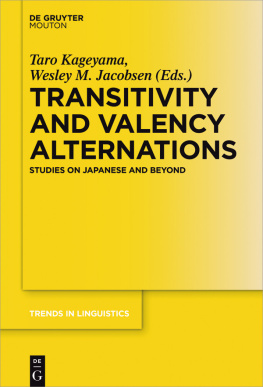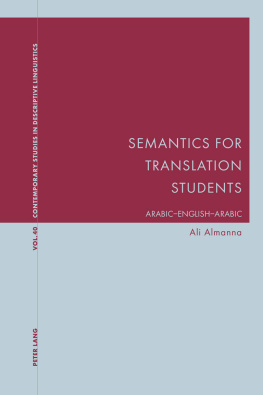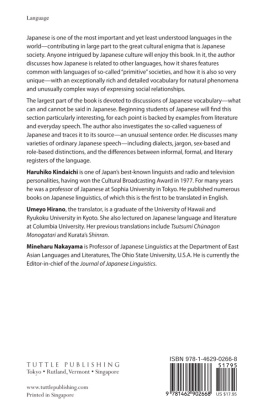Guide

Taro Kageyama and Wesley M. Jacobsen (Eds.)
Transitivity and Valency Alternations
Trends in Linguistics
Studies and Monographs

Editor
Volker Gast
Editorial Board
Walter Bisang
Jan Terje Faarlund
Hans Henrich Hock
Natalia Levshina
Heiko Narrog
Matthias Schlesewsky
Amir Zeldes
Niina Ning Zhang
Editor responsible for this volume
Volker Gast
Volume 297

ISBN 978-3-11-047524-1
e-ISBN (PDF) 978-3-11-047715-3
e-ISBN (EPUB) 978-3-11-047530-2
ISSN 1861-4302
Library of Congress Cataloging-in-Publication Data
A CIP catalog record for this book has been applied for at the Library of Congress.
Bibliographic information published by the Deutsche Nationalbibliothek
The Deutsche Nationalbibliothek lists this publication in the Deutsche Nationalbibliografie;
detailed bibliographic data are available on the Internet at http://dnb.dnb.de.
2016 Walter de Gruyter GmbH, Berlin/Boston
Typesetting: RoyalStandard, Hong Kong
www.degruyter.com
Taro Kageyama and Wesley M. Jacobsen
Introduction
Taro Kageyama , National Institute for Japanese Language and Linguistics
Wesley M. Jacobsen , Harvard University
1Transitivity and verb alternations
Understanding the way languages encode alternations in the transitivity of verbs is key to understanding numerous and wide-ranging phenomena in the syntactic, semantic, and morphological behavior of languages. Transitivity is fundamentally concerned with the valency of a verb the number of arguments it takes, something which can be altered either by syntactic means such as passivization and causativization or by morphological devices for changing the lexical form of a verb that vary widely from language to language. English is a language that does not employ such morphological means to mark transitive alternations, as seen in the unchanged shape of the verb in transitive versus intransitive sentence pairs such as The baby spilled the milk and The milk spilled . In the absence of such form-meaning correspondences of a morphological kind, transitivity alternations in English have been treated in a wide spectrum of primarily non-morphological approaches, beginning with early generative grammar (e.g. Lakoff 1970; Guerssel et al. 1985) and extending to more recent lexicon-based analyses (e.g. Levin & Rappaport Hovav 1995; Everaert et al. [eds.] 2012) and typological approaches (e.g. Haspelmath 1993; Nichols et al. 2004). A different mechanism for marking transitivity alternations is seen in languages that employ reflexive pronouns or suffixes to convert transitive forms to intransitive forms (Geniuien 1987; Schfer 2008). Japanese may be seen to occupy a midway position between English-type languages that involve no overt marking and reflexive-type languages that use a single means to consistently mark transitivity alternations in the direction of transitive to intransitive. Japanese marks transitivity alternations by means of verb suffixes that pattern into various directional types, including transitive to intransitive, intransitive to transitive, or in neither direction. There is therefore no one-to-one correspondence in Japanese between transitive function and the morphological shape of transitivity-changing suffixes, presenting a complex picture of the relationship among transitive-intransitive pairs that is not quite like that found in any other language. In light of the fact that influential work in this area has so far been confined primarily to English and other European languages, a detailed study of the unique properties of Japanese valency alternations thus has the potential to shed fresh light on the nature of valency change as a universal phenomenon of human language.
Growing out of an international conference on Valency Classes and Alternations in Japanese held on August 4th and 5th, 2012, at the National Institute for Japanese Language and Linguistics (NINJAL) in Tokyo, Japan, the present volume is the first in English dedicated to transitivity alternations in Japanese from a multidisciplinary perspective, representing the culmination of the progressively deepening interest this topic has attracted over a broader and broader range of fields in linguistics over the past quarter century. The fifteen chapters in the volume, thirteen of which originate in presentations given at the conference, include work by specialists in a diversity of fields ranging from the syntax, semantics, and morphology of contemporary standard Japanese to dialects of Japanese, earlier historical stages of the language, first and second language acquisition, and language typology.
This volume aims for adequacy of description and analysis rather than coherence of theoretical framework, so that the theoretical perspectives found in these chapters are varied. This approach is, we believe, the right one for a phenomenon so complex and multifaceted in character as transitivity alternations, one that cuts through the heart of the Japanese verbal system and leaves virtually no aspect of the language untouched. The contributions in this volume, we trust, fully bear this out, not only for the way they bring to light new data on myriads of properties particular to transitivity phenomena in Japanese, but in the deeper understanding they offer of the cross-linguistic dimensions of transitivity and valency alternations.
The current volume serves as a companion to the Handbooks of Japanese Language and Linguistics series (edited by Masayoshi Shibatani & Taro Kageyama and published by De Gruyter Mouton). Although the series is intended to provide a comprehensive coverage of the grammar, history, and use of the Japanese language, the topic of transitivity alternations was considered to exceed in its wide-ranging scope the ability to be fully treated in a single chapter in this series, and to merit treatment in a separate volume of its own such as this. This volume also serves as a complement to the online database entitled The World Atlas of Transitivity Pairs (NINJAL 2014), where transitive/ intransitive alternation patterns involving 31 verb pairs listed in Haspelmath (1993) are collected from about 60 languages across a variety of language families and language groups and visually compared. This atlas may be accessed on the NINJAL website, where the raw data are also downloadable.
2The basic phenomenon in Japanese
As noted above, Japanese manifests differences in transitivity (transitive vs. intransitive) by means of formal distinctions marked on the predicate. Specifically, the differences appear in the form of affixes that distinguish transitive vs. intransitive members of verb pairs, such as nao-s-u tr. fix vs. nao-r-u intr. be fixed, ak-e-ru tr. open vs. ak-u intr. open, ue-ru tr. plant vs. uw-ar-u intr. be planted, etc. Transitive-intransitive verb pairs typically fall into sentence patterns such as those in (1), associated with the syntactic and semantic properties listed in (2).

| (2) | a. | The transitive verb requires one noun argument more than the intransitive verb. |
| b. | The noun arguments of the transitive and intransitive members are case marked as follows, so that the noun argument of the transitive member receiving accusative marking corresponds to the noun argument of the intransitive verb receiving nominative marking, represented here by NP2 (= panku punctured tire in the earlier example (1)): |














